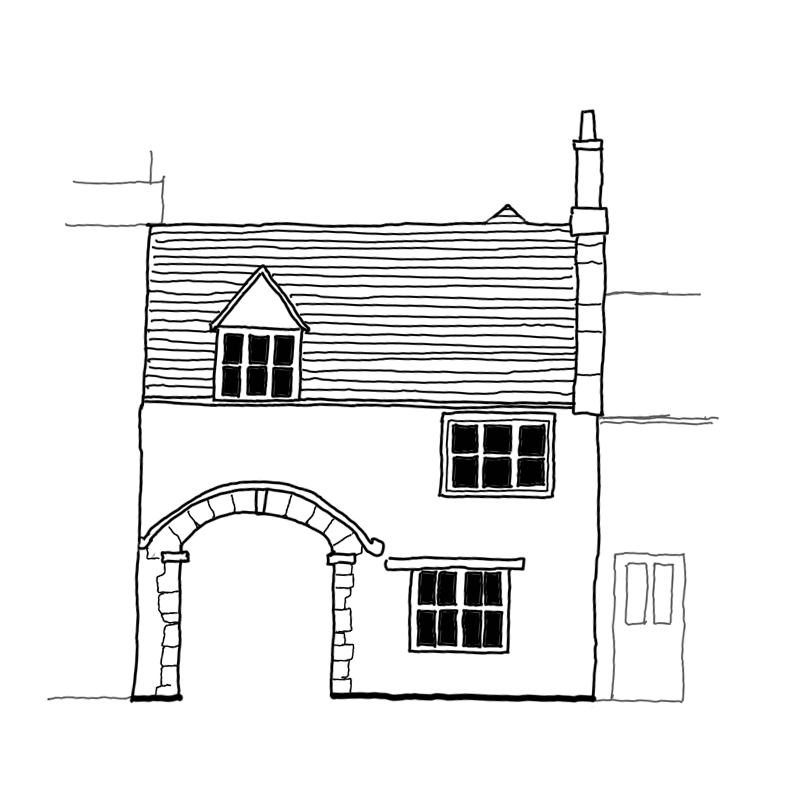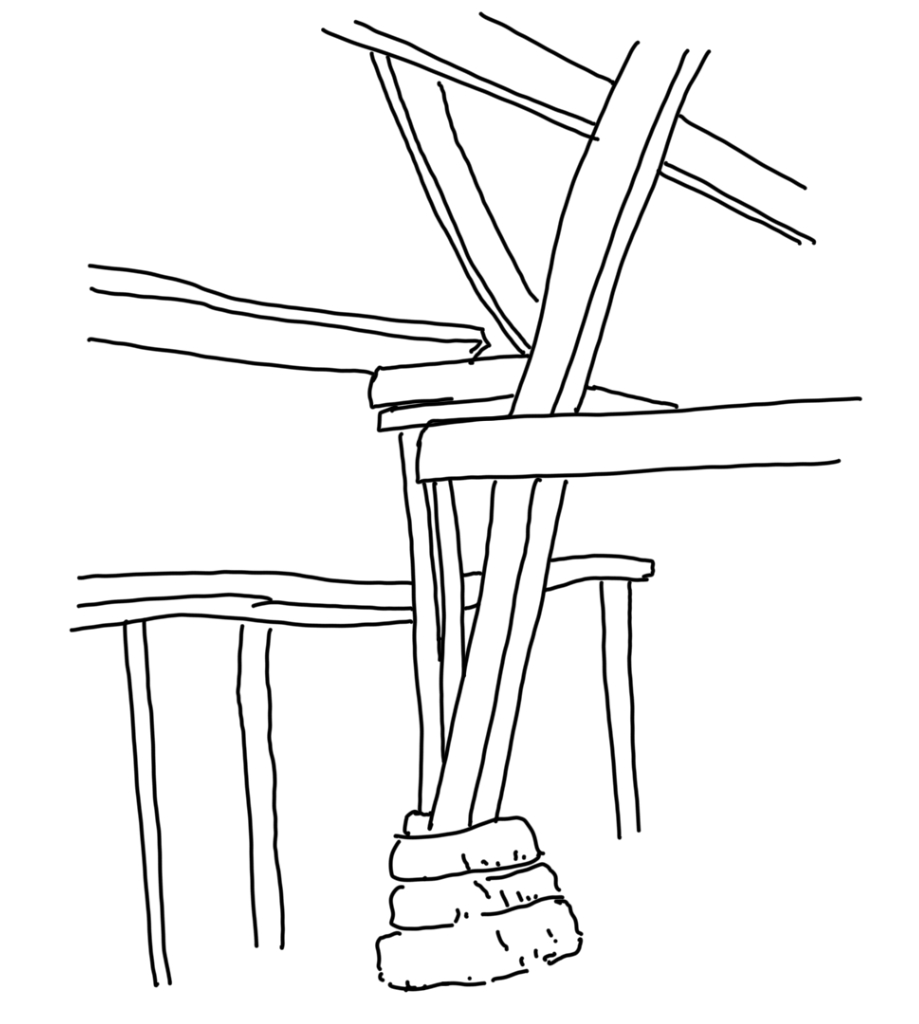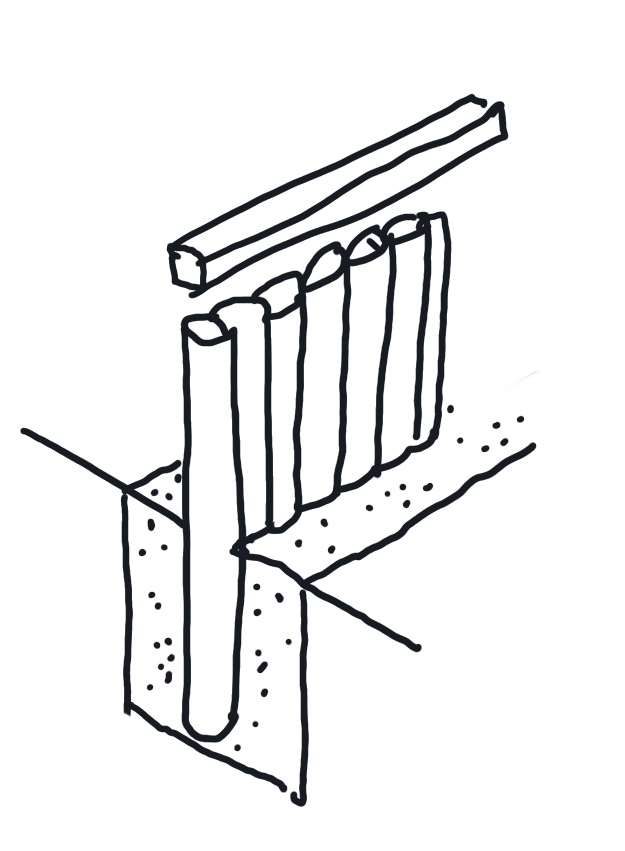Construction of timber buildings and Roofs
one way of shaping a building to resist wind force was to add extension or aisles at the sides or ends… 22
Consciously or unconsciously, traditional carpenters also made use of triangulation
Did the early carpenters understood and knowing if it was still or strong
shear, self-load, dead load, torsion.
I doubt it. they understood if it was flimsy or weak.
PRE–FRAMING
What came before the surviving timber- framed construction?
the earlier structures relate to an abundance of timber rather than a scarcity. Early forest clearance. felling trees simply to clear them, and then u swig o sing the by-product of land clearance as a mass building material. n.

English woodland was not good for, lodge-pole type trees. (douglas fir etc), unless you went far north.
NC. In log-cabin type constructions, the logs were seen as elongated bricks…plus, they didn’t have to dig a trench before commencing. So why did they building with earthbound vertical? Maybe it was because only recangular houses are possible with horizontal logs, (not circular) and maybe you needed the logs to be regular in size and diameter. Vertical log was more forgiving, you weren’t dependant on the preceeding log being straight and level.
In the absence of quality tools, the fewer and simpler the joints, the better.
But once the logs had to be hauled further from the forest, to move permanently settled sites, the economical use of materials became a factor.. n.
Horizontal log construction was abandoned and spaced-vertical, earth-fast
construction was adopted… n.
like fencing posts
In such construction, roofing problems began to occur. Theres was no long a continuous upper surface on which the feet of the rafters could bear, instead it was necessary to introduce a continuous wall-plate, ling the tops of all the posts, or to allow for linking opposite posts with some sort of tie abve which a roof could rise. 26
When it was realised that vertical timbers do not need to be earth-fast to ensure stability but could be made stable through framing (nc. surely an alternative to earth-fast was being sought due to the need to excavate, the rotting problem – not soley stablitly), and once the tools and jointing techniqes essential for framing had become available, the type of timber-braced construction which shows the carpenters crafter could be produced. 26.
the selection of structural timber was as much part of the craft of the carpenter as the choice of meat at the market is part of the
butchers skill… 27
A wood or coppice could be cultivated by a medieval community to produce a regular supply of thin coppice wood for fires or charcoal-making and tall standards for timber building 27.
There was a greatly increased demans for charcoal in the late 18c, and for ship’s timbers in the 19c. This meant that the supply of home-produced timber was inadequate. ..27. (nc. but I thought the switch away from timber was during the 17c, or was this just in Burford).
It was customary to fell the trees in winter so that the green timber was easily worked, then building began in sping. However, the bark was more easily peeled when the sap was rising, so it became practice to fell in spring. Bark was much in demand by tanners, and could be worth as much as the timber itself, (nc, so bark-stripping must have been upmost in the mind of the tree-fellers).

Transport was the unknown but considerable cost of getting timber from the felling point to the building point. nc. The further into the forest the carpenter had to penetrate in order to find find suitable mater the greater was the cost of dragging the timber to the road. The longer to the building site hauling logs on pairs of wheels with teams of oxen. The more preliminary work that could be done at the felling site, the less the load to be transported. ..28.
A16c farmhouse in West Suffolk has shown that no fewer than 330 seperate trees were felled and used in its construction. Some large, some small. Most of these were small and used for rafters joists and studs-only a few being suitable for posts, tie beams and wall plates.
Structural timber was generally used unseasoned. Green timber was easier to work with. (nc. I have read somewhere that they would season the timber before use) –
Withdrawable hook pins were used for temporary security at the joints until the final pegs we driven home.
As much assembly was done on the ground, including root trusses, adjusting and modifying until it fitted together properly, then taken apart and re-assembled on site ready to be reared or hoisted into position.

The raising of the larger frames needed more than a small gang of carpenters, so a ‘raising bee’ was held where the many of the community would come together in a ‘party’ (my words) and a feast and celebration would be held for the creation of a new building. The building owner was expected to cover the cost of food and drink, which ancients accounts show, was not cheap. 35.
(my view on this is that the ‘party’ of people would only be needed for their sheer strength, or some other simple task, such as raising large section pieces, which could be simply assembled into a growing frame.
continue on page 2
